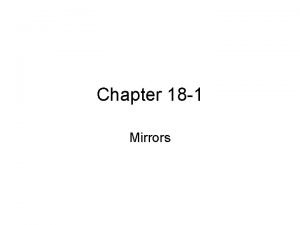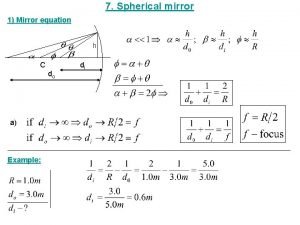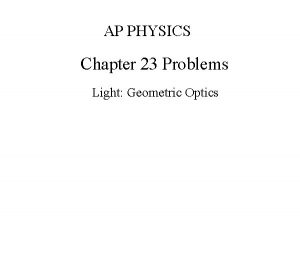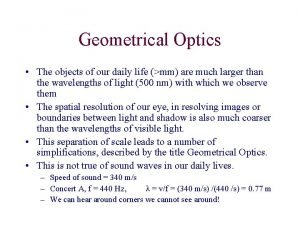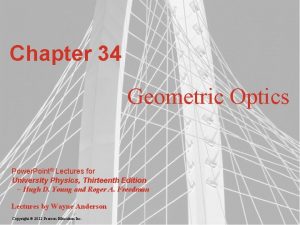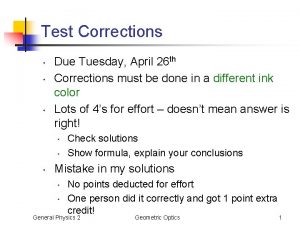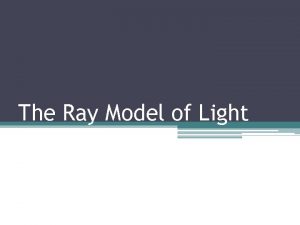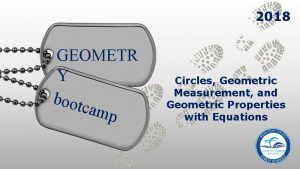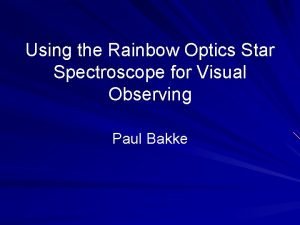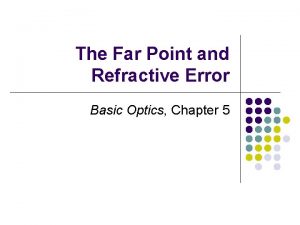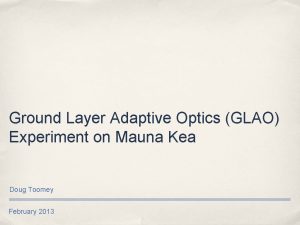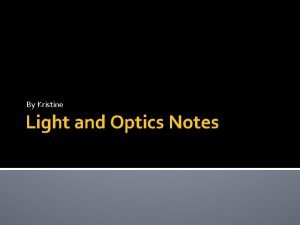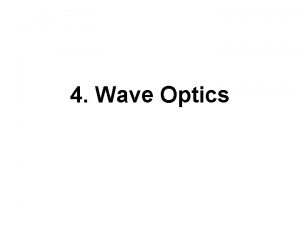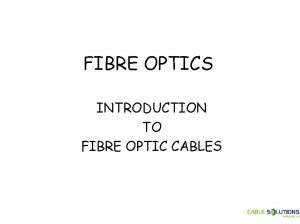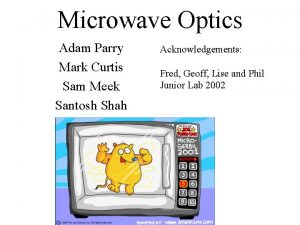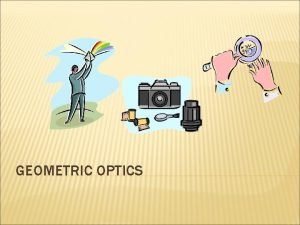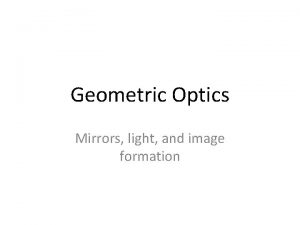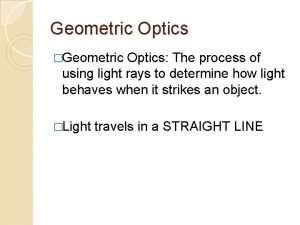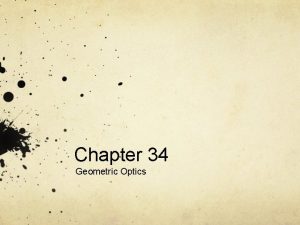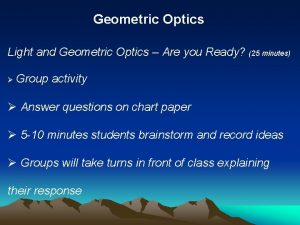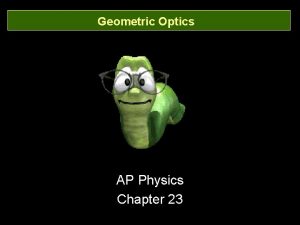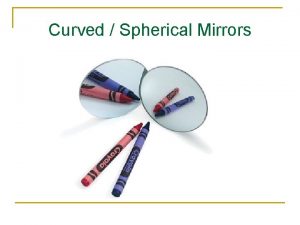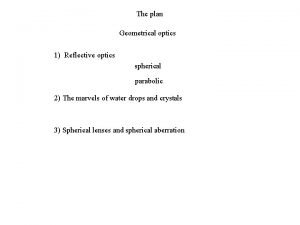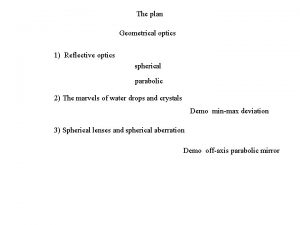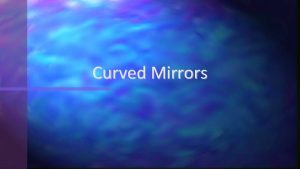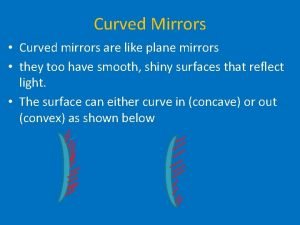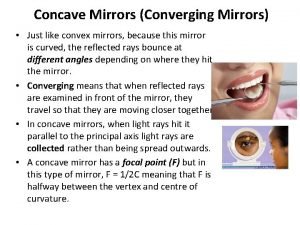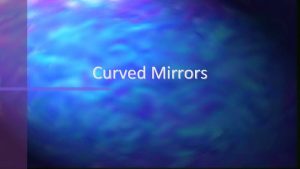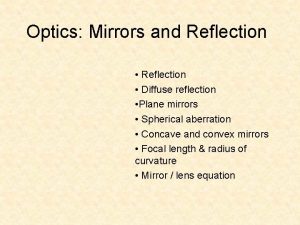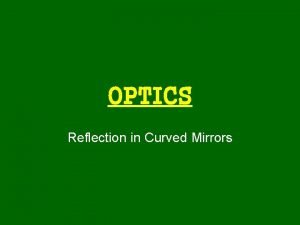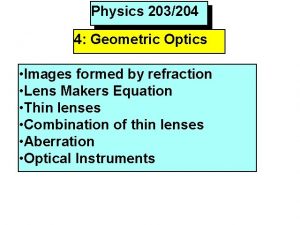GEOMETRIC OPTICS SPHERICAL MIRRORS Mirrors that are formed

































- Slides: 33

GEOMETRIC OPTICS

SPHERICAL MIRRORS Mirrors that are formed from a section of a sphere. Convex: The reflection takes place on the outer surface of the spherical shape Concave: The reflection surface is on the inner surface of the sphere.

OBJECTS FROM FAR AWAY If objects are infinitely far away from a mirror (The sun, the stars, etc), the rays would be precisely parallel. The law of reflection holds for each of the parallel rays and they will all reflect to be brought to a single point.

3 STEPS TO A RAY DIAGRAM FOR SPHERICAL MIRRORS Ray 1: drawn parallel to the principle axis, and then passes through the focal point after reflection.

3 STEPS TO A RAY DIAGRAM FOR SPHERICAL MIRRORS Ray 2: drawn through F; therefore must reflect parallel to the principle axis.

3 STEPS TO A RAY DIAGRAM FOR SPHERICAL MIRRORS Ray 3: Perpendicular to the mirror, passes through the radius of curvature.

RAY DIAGRAM

SUMMARY Ray 1 goes from object parallel to the axis and reflects through the focal point. Ray 2 goes from object through focal point and reflects parallel to the axis. Ray 3 goes from object, perpendicular to the mirror, reflects back on itself through the center of curvature.

TYPES OF IMAGES Virtual Image: If a film or paper were placed in the location of the image, rays would not actually pass through this location. Real Image: light does pass through the location of the image. If a film were placed at the image position, light would be put onto the film.

OTHER WAYS TO FIND IMAGES We could always use ray diagrams, but accuracy is difficult. Mirror equation S represents distance of image and object. f represents the focal length.

MAGNIFICATION Magnification is the image height divided by the object height. Sign conventions Positive image height means upright, negative is inverted relative to the object. Positive distance is in front of the mirror, and negative is behind the mirror.

PRACTICE #1 A 1. 50 cm high diamond ring is placed 20 cm from a concave mirror whose focal length is 15 cm. Determine the position and size of the image.

INDEX OF REFRACTION The speed of light in a vacuum is 3. 0 x 108 m/s In other mediums, the speed of light is less. We call the ratio of the speed of light in a vacuum to the speed of light in another medium the index of refraction

MORE ABOUT THE INDEX OF REFRACTION Can a material’s index of refraction ever be less than 1? Some indices of refraction that are useful: Air – 1. 0003 Water – 1. 33 Crown glass – 1. 52 Lucite (Plexiglass) – 1. 51 Diamond – 2. 42

SNELL’S LAW When light hits the boundary of two mediums, some of the light is reflected and some passes into the new medium. Since the ray of light will be traveling at a different speed, its path is bent. This is called refraction. Bending Light - Index of Refraction, Light, Snell's Law - Ph. ET

SNELL’S LAW As light passes from a medium with a low index of refraction to one with a higher index, the light ray will be refracted towards the normal.

SNELL’S LAW As light travels from a medium with a higher index of refraction to one with a smaller index, the light is refracted away from the normal.

SNELL’S LAW Remember, angle of incidence and now angle of refraction, are both measured from the normal

TOTAL INTERNAL REFLECTION As light passes from one material to another where the index of refraction is less (water into air for example), the light bends away from the normal. At a particular incident angle, the angle of refraction will be 90 degrees. This is called the critical angle.

TOTAL INTERNAL REFLECTION The incident light is at such an angle that all of the light is reflected. This will only occur if n 1 > n 2 Many technological usages of total internal reflection: Binoculars Fiber optics endoscopes

THIN LENSES A lens is made up of two faces that are usually portions of a sphere. The two faces can be either concave or convex. We only use thin lenses in this class which means that the diameter of the lens is small compared to the radii of curvature of the two lens surfaces.

TYPES OF LENSES Converging lens: a lens that is thicker in the center than at the edges makes parallel rays converge to a point. Diverging lens: a lens that is thinner in the center than at the edges makes parallel rays diverge. The focal point is defined as the point from which refracted rays seem to have emerged from as a single point.


3 STEPS TO A RAY DIAGRAM FOR THIN LENSES Ray 1: parallel to the axis and then refracted through the focal point on the opposite side.

3 STEPS TO A RAY DIAGRAM FOR THIN LENSES Ray 2: Passes through the F’ on the same side of the lens as the object and then goes parallel to the axis beyond the lens.

3 STEPS TO A RAY DIAGRAM FOR THIN LENSES Ray 3: directed towards the very center of the lens, and emerges the same angle as it entered.

SUMMARY Ray 1: leaves the top of the object going parallel to the axis and then refracts through the focal point. Ray 2: passes through F’ and leaves the lens parallel to the axis. Ray 3: goes straight from the object through the center of the lens and back out the same angle.

REAL VS. VIRTUAL IMAGES Notice, that in the case of a lens, the light of the image, on the opposite side of the lens, is able to be detected by film. Opposite than a mirror, a real image is on the opposite side of the lens. A virtual image is on the same side of the lens.

DIVERGING LENS

ANALYTICALLY Luckily it is the same as the mirror equations

SIGN CONVENTIONS The focal length is positive for converging lenses and negative for diverging lenses. The object distance is positive if it is on the side of the lens from which the light is coming (this is usually the case, although when lenses are used in combination, it might not be so); otherwise, it is negative

MORE SIGN CONVENTIONS The image distance is positive if it is on the opposite side of the lens from where the light is coming; if it is on the same side, then it is negative. If the image distance is positive, then the image is real. The height of the image is positive it if it is upright.

PRACTICE #1 What is the position and the size of the image of a large 7. 6 cm high flower placed 1. 0 m from a +50 mm focal length camera lens?
 Reflection and refraction venn diagram
Reflection and refraction venn diagram Antigentest åre
Antigentest åre Difference between ray optics and wave optics
Difference between ray optics and wave optics Spherical aberration in mirrors
Spherical aberration in mirrors What is the mirror equation
What is the mirror equation The new cartesian sign convention for spherical mirrors
The new cartesian sign convention for spherical mirrors Geometric optics problems
Geometric optics problems Geometric optics in real life
Geometric optics in real life Geometric optics ppt
Geometric optics ppt Geometric optics
Geometric optics Two parts that make up most mirrors
Two parts that make up most mirrors Thể thơ truyền thống
Thể thơ truyền thống Tìm vết của đường thẳng
Tìm vết của đường thẳng Sau thất bại ở hồ điển triệt
Sau thất bại ở hồ điển triệt Thơ thất ngôn tứ tuyệt đường luật
Thơ thất ngôn tứ tuyệt đường luật Hãy nói thật ít để làm được nhiều
Hãy nói thật ít để làm được nhiều Phân độ lown ngoại tâm thu
Phân độ lown ngoại tâm thu Tôn thất thuyết là ai
Tôn thất thuyết là ai Block av độ 2
Block av độ 2 Chiến lược kinh doanh quốc tế của walmart
Chiến lược kinh doanh quốc tế của walmart Gây tê cơ vuông thắt lưng
Gây tê cơ vuông thắt lưng A closed geometric figure formed by lines
A closed geometric figure formed by lines Circles geometric measurement and geometric properties
Circles geometric measurement and geometric properties Rainbow optics star spectroscope
Rainbow optics star spectroscope Ledlink optics inc
Ledlink optics inc Far point of emmetropic eye
Far point of emmetropic eye Dlp
Dlp Adaptive optics
Adaptive optics The computational complexity of linear optics
The computational complexity of linear optics Light and optics notes
Light and optics notes Fourier optics
Fourier optics Optics
Optics Curtis parry
Curtis parry Physics 241
Physics 241



